How New Sellers Can Succeed on Walmart Marketplace: A Step-by-Step Guide
Walmart Marketplace is quickly emerging as a major player in the eCommerce space, offering an opportunity for online sellers to scale beyond platforms like Amazon and eBay. With over 150 million monthly visitors, trusted brand credibility, and a less saturated environment, it’s an ideal channel for sellers looking to diversify and grow.
But for new sellers, the path to success can feel confusing. Account approvals, product listings, pricing strategies, and fulfillment choices; there’s a lot to juggle, and it’s easy to get stuck before even launching.
This step-by-step guide is designed to simplify that journey. Whether you’re a small business owner or an experienced seller, you’ll learn how to set up your account, optimize listings, leverage Walmart’s tools, and gain real traction.
If you’re serious about scaling your business, Walmart Marketplace could be the growth channel you’ve been waiting for, and this guide will show you how to make it happen.
Step-by-Step Guide to Getting Started on Walmart Marketplace
Check out the steps carefully to start as a new seller on Walmart Marketplace.
Step 1- Meet the Eligibility Requirements
Before you can join the ranks of successful Walmart Marketplace sellers, you need to clear a few basic eligibility checks. Walmart is selective about who it allows onto its platform, and for good reason: it wants to maintain high standards for both products and customer experience.
To apply, you’ll need to have:
- A legally registered U.S. business.
- A U.S. business address for operations.
- A valid W-9 tax form and EIN.
- A unique product identifier, like a GTIN or UPC, for each listing.
- Strong fulfillment capabilities and reliable customer service support.
Tip: Get all your documents ready before you begin the application. Delays in paperwork are one of the most common reasons sellers lose momentum early on.
Being well-prepared shows Walmart you’re serious, professional, and ready to grow, traits they look for when approving new sellers. Think of it as laying the foundation for long-term success.
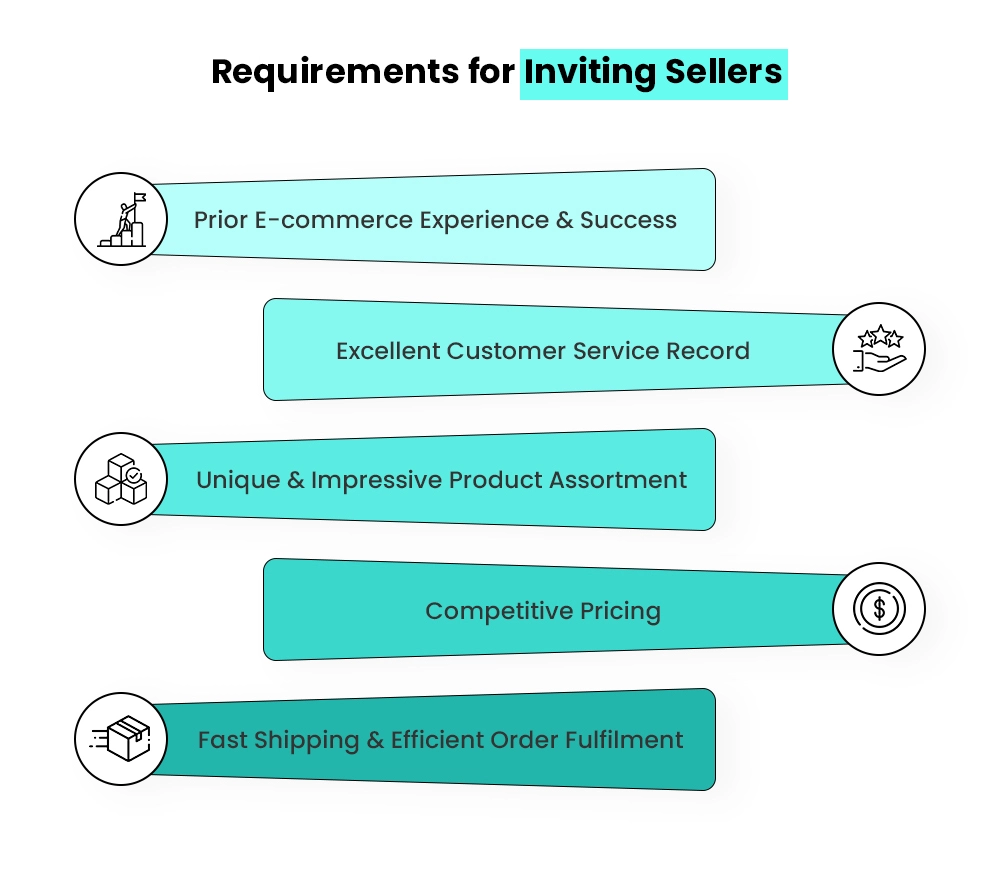
Step 2- The Application Process
Once you’ve gathered all your documentation, it’s time to apply to Walmart Marketplace. Head over to seller.walmart.com and click on “Join Marketplace” to begin your application. You’ll be asked to provide your business details, tax ID, product categories, and information about your fulfillment capabilities.
Walmart values accuracy and professionalism, so take your time filling out the application. Double-checking for errors, missing or incorrect information can delay your approval.
After submission, the typical waiting period is 1–2 weeks, although it can vary. During this time, Walmart reviews your application to ensure you meet their standards for product quality, pricing, and customer service.
Tip: Be honest and thorough. If you’re clear and organized, you’ll likely move through the process faster.
Once approved, you’re officially set to start selling on Walmart Marketplace, a major step toward expanding your eCommerce reach and building a profitable storefront.
Step 3: Setting Up Your Seller Center Account
Once your application is approved, it’s time to dive into Walmart’s Seller Center—your main dashboard for managing everything from orders to inventory. This step is crucial because the way you set up your account impacts how smoothly your operations run from day one.
Here’s how to get started:
- Complete your business profile: Add your logo, brand story, and contact info to build trust with customers. A polished seller profile adds credibility and makes your store feel more professional.
- Set up payment info: Walmart partners with Payoneer and Hyperwallet for secure payments. Make sure your bank details are accurate to avoid payout delays.
- Configure shipping and return policies: Walmart allows sellers to choose their shipping methods. Be clear and competitive with delivery times and return processes to attract more buyers.
- Establish tax settings: Provide accurate state tax info based on where your business operates and sells.
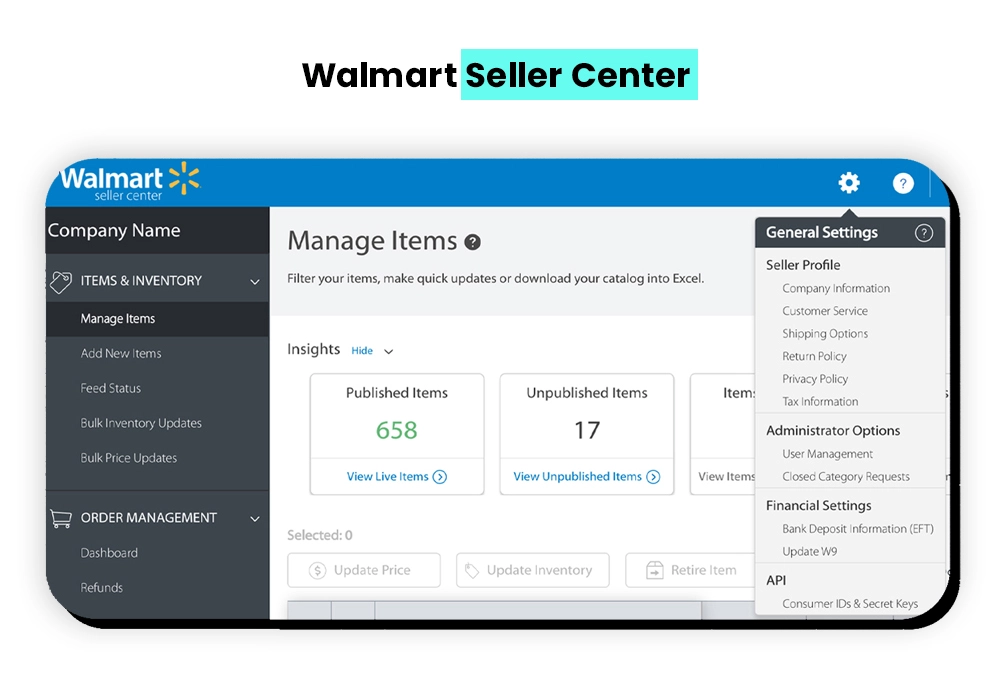
Navigating Walmart Marketplace for new sellers might feel overwhelming at first, but the Seller Center is designed to be intuitive and easy to manage. For eCommerce businesses, a well-optimized setup here leads to fewer issues later, smoother order fulfillment, and higher customer satisfaction.
Tip: Take your time with this step; it sets the foundation for long-term success.
Step 4: Product Listing and Optimization
Creating strong product listings is essential when you’re selling on Walmart Marketplace. Unlike other eCommerce platforms, Walmart customers are more value-conscious—they expect clear details, honest pricing, and a seamless buying experience. Here’s how to make your listings work harder for you:
1. Product Feed Management
Getting your products live starts with the right upload method:
- Manual Upload: Great for small catalogs or one-off items.
- Bulk Upload: Use Excel templates if you’re adding many products at once.
- Third-Party Integrators: Tools like CedCommerce, Shopify, or ChannelAdvisor can automate listing and inventory sync for larger stores.
2. High-Quality Product Titles
Craft titles that are direct, keyword-rich, and informative:
- Include brand name, product type, and a top feature.
- Example: “AeroFit Resistance Bands Set – Heavy Duty, 5 Levels”
- Avoid keyword stuffing; clarity always wins.
3. Compelling Product Descriptions
Don’t just describe—sell the product:
- Start with a short, benefit-driven intro.
- Use bullet points to list features and technical specs.
- Weave in a little storytelling to show how the product fits into everyday use.
4. Essential Product Attributes
Make sure to include all required attributes such as:
- Size, color, material, weight, and compatibility. These improve search visibility and help shoppers filter accurately.
5. High-Resolution Images
Visuals make or break your listing:
- Use clear, high-resolution photos (at least 1000x1000px).
- Include multiple angles and zoomable views.
- Add one lifestyle image to show real-world use.
- The main image should be on a white background (Walmart’s requirement).
6. SKU and UPC Management
- Assign accurate SKUs for internal tracking.
- Ensure UPCs are valid and match Walmart’s database.
- Mistakes here can cause listing errors or inventory issues.
7. Keyword Research for Walmart
Walmart’s search behavior is different from Amazon’s or Google’s. Use:
- Tools like Helium 10, DataHawk, or Walmart’s Keyword Tool.
- Focus on high-volume, value-driven search terms.
- Include keywords naturally in titles, bullet points, and descriptions.
By checking all these boxes, your listings won’t just appear—they’ll perform. Remember, optimized content builds trust, improves discoverability, and increases conversions—exactly what you need to succeed when selling on Walmart Marketplace.
Step 5: Inventory Management and Fulfillment
Once your listings are ready, the next step is figuring out how you’ll get products to your customers. When you become a seller on Walmart Marketplace, choosing the right fulfillment method is critical for smooth operations and great customer experiences, both online and in-store.
You have two main options: self-fulfillment or Walmart Fulfillment Services (WFS).
Self-fulfillment means shipping orders from your warehouse or through dropshipping partners. It offers more control and flexibility but requires reliable logistics, timely delivery, and clear return policies. If you’re just starting, managing it all yourself can be overwhelming.
On the other hand, WFS allows Walmart to handle storage, packing, shipping, and even customer service. This builds trust with customers, boosts your chances of winning the Buy Box, and helps your products qualify for fast shipping tags. WFS is currently open to select categories and sellers who meet performance standards, so make sure to check your eligibility and the latest requirements.
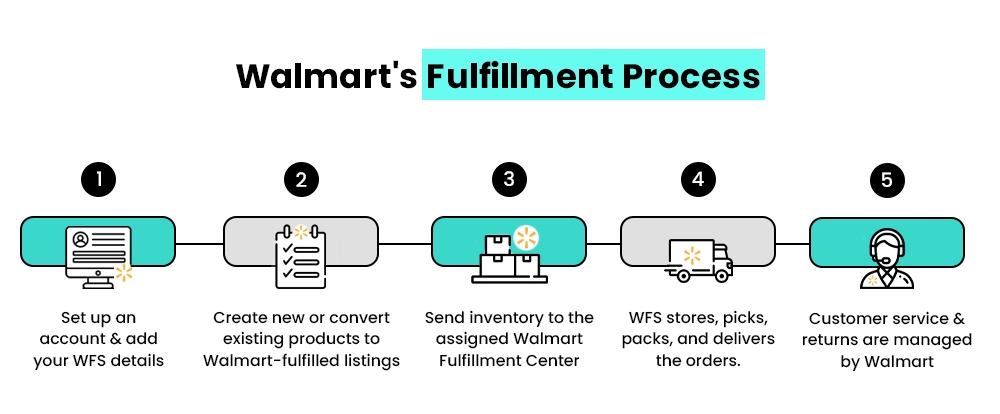
No matter which route you choose, set up inventory syncing tools to prevent overselling or stockouts. Platforms like Shopify, Sellbrite, or Walmart-approved integrators can help.
Each method has its pros and cons—so weigh your resources, goals, and product type before committing. The right fulfillment strategy can make or break your success on Walmart Marketplace.
Step 6: Pricing Strategy
Getting your pricing right is crucial if you want to successfully sell on Walmart Marketplace. Walmart is known for offering great value, so competitive pricing is one of the biggest factors that influence whether your product gets visibility or remains unnoticed.
To stay competitive and profitable, keep these pricing tips in mind:
- Research competitor pricing on Walmart and similar platforms to benchmark your products.
- Factor in shipping and seller fees before setting prices to avoid unexpected losses.
- Use automated repricing tools like RepricerExpress, SellerActive, or Walmart’s built-in repricing option to stay competitive without constant manual updates.
- Clearly define your value proposition—what makes your product worth the price? It could be higher quality, bundling, or exclusive features.
Walmart’s algorithm favors listings that offer strong value to customers, so pricing competitively doesn’t always mean being the cheapest. It’s about balancing affordability with quality and convenience.
A well-thought-out pricing strategy will not only increase your chances of winning the Buy Box but also help you scale sustainably. As a new seller, smart pricing enables you to gain trust and traction fast, both online and in-store.
Step 7: Customer Service Excellence
One of the often-overlooked benefits of Walmart Marketplace is its strong focus on customer satisfaction. As a seller, offering top-notch service isn’t optional—it’s essential. Great customer support not only builds trust but also improves your seller ratings and increases your chances of winning the Buy Box.
Here’s how to stand out through excellent service:
- Respond quickly to customer inquiries via the Seller Center dashboard—Walmart expects replies within 24 hours or sooner.
- Handle returns and refunds efficiently and fairly. A smooth return experience builds credibility and encourages repeat buyers.
- Use proactive communication to update customers about shipping delays, product issues, or out-of-stock situations before they escalate.
Walmart’s system rewards sellers who consistently deliver quality service with better visibility, higher seller scores, and greater marketplace privileges.
The bottom line? Treat your customers well, and Walmart will treat your business well in return. Providing excellent customer service isn’t just good practice—it’s a key growth strategy on Walmart Marketplace.
– Also Read- 9 Reasons Walmart Marketplace Is a Game-Changer for eCommerce Sellers
Strategies for Long-Term Success on Walmart Marketplace
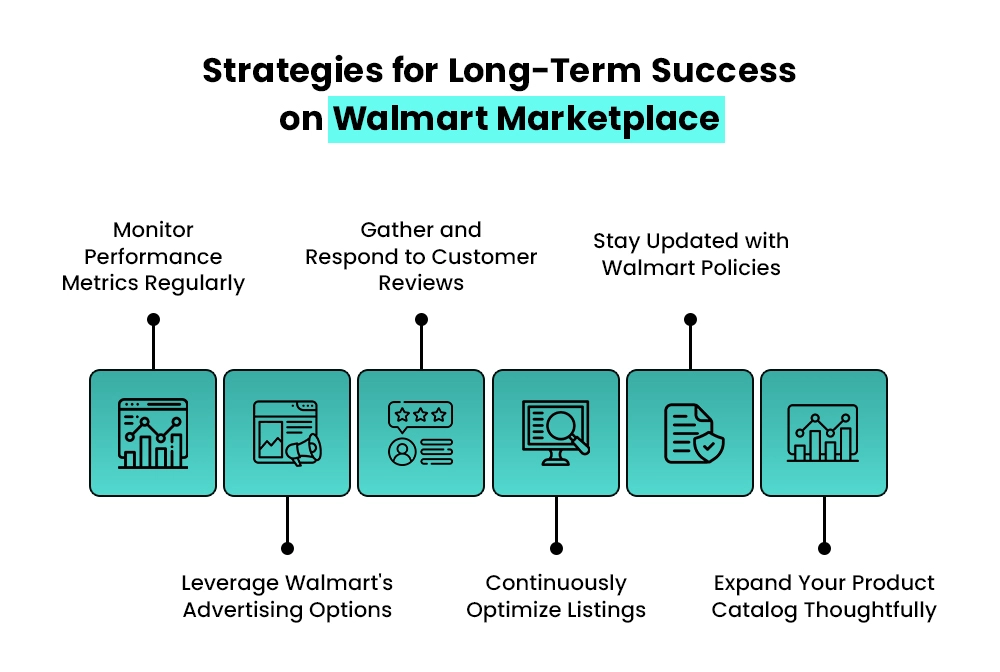
Check out the important strategies that can help you as a Walmart marketplace seller:
1. Monitor Performance Metrics Regularly
Long-term success on Walmart Marketplace doesn’t just happen—it’s built through consistent performance and smart decision-making. One of the key ways online retailers can stay ahead is by regularly monitoring their Seller Scorecard.
Keeping tabs on metrics like order defect rate, on-time shipping, and customer feedback helps you identify weak spots before they hurt your rankings or sales. Walmart rewards reliable sellers, so staying on top of your performance can directly impact visibility and growth.
One of the biggest Walmart Marketplace benefits is that high-performing sellers are more likely to win the Buy Box and rank higher in search results. Use these insights to fine-tune your operations, improve customer satisfaction, and stay competitive in a fast-moving marketplace.
2. Leverage Walmart’s Advertising Options
If you’re serious about selling with Walmart, advertising isn’t optional; it’s essential. Walmart offers powerful tools to help you boost visibility and drive sales, especially when you’re just starting.
Here’s a quick breakdown for new sellers:
- Sponsored Products: These ads promote individual items directly in Walmart’s search results and product pages. Great for driving traffic to bestsellers or new listings.
- Walmart Connect: A broader suite of ad solutions that includes display ads, search ads, and off-site advertising to target shoppers across the web.
The right Walmart advertising strategy helps you reach ready-to-buy customers at the right moment. Even a modest budget can deliver strong results if you focus on well-optimized listings and high-intent keywords. As you grow, your ad performance data will guide smarter decisions, allowing you to scale efficiently and sustainably.
– Also Read- How to Create Your First Paid Social Media Campaign (Step-by-Step)
3. Gather and Respond to Customer Reviews
Customer reviews play a major role in building trust, and for eCommerce sellers, they can make or break a product’s success. New sellers should focus on collecting honest feedback and responding thoughtfully to build credibility and long-term brand loyalty.
Here’s how to make reviews work for you:
- Encourage reviews by following up post-purchase with a friendly message asking customers to share their experience.
- Respond to negative feedback calmly and professionally. Show that you care and are willing to make things right.
- Use feedback to improve whether it’s shipping times, product quality, or listing accuracy.
By treating reviews as a valuable feedback loop, you’ll improve customer satisfaction and trust. Plus, they give you insights to optimize your product listings and deliver a better buying experience, helping you grow sustainably on Walmart Marketplace.
4. Continuously Optimize Listings
Success on Walmart Marketplace isn’t just about getting your products listed; it’s about keeping them competitive. One of the most effective ways to drive more traffic and conversions is by continuously optimizing your product listings.
Here’s how to do it:
- A/B test titles and descriptions to see which versions drive more clicks and sales. Small changes like clearer keywords or benefit-focused language can make a big difference.
- Refresh your images regularly, ensuring they’re high-quality, accurate, and lifestyle-oriented where possible.
- Update product attributes and backend keywords to improve search visibility.
These ongoing tweaks help your listings stay relevant and appealing in a crowded marketplace. Walmart’s algorithm favors well-performing listings, so continual optimization can lead to better placement, more visibility, and higher conversion rates. Treat your listings as dynamic assets, not set-it-and-forget-it pages, and you’ll build a stronger, longer-lasting presence.
5. Stay Updated with Walmart Policies
Selling on an online marketplace like Walmart means playing by the rules, and those rules can change often. Staying updated with every Walmart policy change ensures your store remains compliant, competitive, and in good standing.
Whether it’s an update to the returns process, adjustments in fulfillment expectations, or new advertising features being rolled out. Every change can directly impact how you operate and perform on the platform.
Missing a policy update might mean delayed shipments, listing issues, or worse, suspension from Walmart Marketplace. By regularly reviewing updates in the Walmart Seller Center and paying attention to emails from Walmart, you’ll be in a stronger position to adapt quickly.
Long-term success starts with being proactive, and knowing the latest policies helps you stay one step ahead while continuing to grow your business with confidence.
6. Expand Your Product Catalog Thoughtfully
As you gain traction on Walmart Marketplace, one smart way to grow is by expanding your product catalog—but do it with intention. Adding more products just for the sake of variety isn’t always effective. Instead, use your existing sales data to identify which items are performing well and what your customers are looking for.
Pay attention to trends, customer inquiries, and seasonal patterns to guide your expansion. If certain products are frequently bought together or have high search volume, that’s a strong signal to introduce complementary items. A thoughtful approach ensures you’re meeting demand without overextending your inventory or marketing efforts.
When done right, expanding your product catalog can boost visibility, improve average order value, and help you capture more market share, setting you up for long-term success on Walmart Marketplace.
Common Pitfalls to Avoid for New Sellers
These are some common pitfalls that you need to avoid as a new Walmart Marketplace seller:
1. Ignoring Eligibility Requirements
Skipping over Walmart’s seller eligibility requirements is a fast track to getting your application denied. It’s easy to get excited about listing the best items to sell on Walmart Marketplace. But if your business details or documentation don’t meet the platform’s standards, you’ll be starting off on the wrong foot.
Take the time to review all criteria before applying—things like product categories, fulfillment plans, and tax details matter. Getting this right from the beginning helps you launch smoothly and increase sales without unnecessary setbacks.
2. Poor Product Data/Incomplete Listings
A common mistake new sellers make on Walmart Marketplace is uploading poor product data or leaving listings incomplete. Missing details like clear titles, bullet-point descriptions, high-quality images, or accurate specs can hurt your product visibility and make shoppers skip over your items.
Walmart’s algorithm favors well-optimized listings, so the more complete and accurate your product info is, the better your chances of showing up in search results. Think of your listing as your shelf space—if it doesn’t look appealing or informative, customers won’t click, and that means lost sales.
3. Slow Shipping or Poor Customer Service
Slow shipping and poor customer service can quickly tank your reputation when you’re dropshipping on Walmart. Shoppers expect fast, reliable delivery and quick responses to questions or issues.
If your shipping times are delayed or you’re unresponsive, negative reviews will pile up—and that hurts your seller rating. Walmart closely monitors performance, and poor ratings can limit your product visibility or even lead to suspension.
To succeed, partner with dependable suppliers and stay proactive with customer support. A smooth post-purchase experience builds trust, repeat buyers, and keeps your dropshipping business running strong.
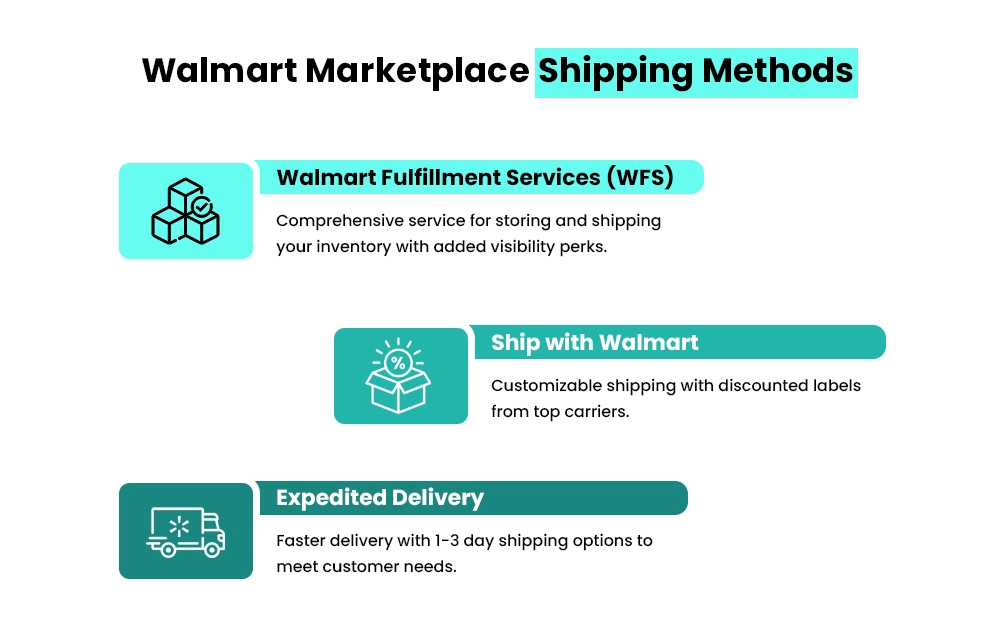
4. Not Understanding Walmart’s Fees
Many new sellers dive into selling on Walmart without fully understanding the platform’s fee structure, and that’s a quick way to lose profits. From referral fees to optional monthly fees for tools or services, these costs can add up fast if you’re not careful.
Ignoring them can lead to pricing mistakes, thinner margins, or even losses on every sale. Before listing your products, take time to review Walmart’s fee breakdown and factor it into your pricing strategy. Knowing what you’ll take home helps you stay competitive and profitable from day one.
Conclusion
Succeeding on Walmart Marketplace isn’t about luck—it’s about having a clear, strategic approach. Start by ensuring you meet all eligibility requirements, then focus on creating complete, optimized product listings that boost visibility and drive conversions.
Stay on top of fulfillment by providing fast, reliable shipping and excellent customer service, especially if you’re dropshipping. Don’t overlook the importance of understanding Walmart’s fee structure to protect your margins and plan smart.
The benefits of selling on Walmart Marketplace are big: access to millions of customers, increased brand exposure, and the potential for steady growth. With the right preparation and mindset, new sellers can thrive.
So, if you’ve been holding back, now’s the time to take the leap. Equip yourself with knowledge, stay consistent, and remember: success on Walmart Marketplace isn’t just possible—it’s within reach. Contact us at Mastroke for better Walmart Marketplace strategies to become a successful seller.
FAQs-
1. How long does it take to get approved as a Walmart seller?
The approval process for Walmart Marketplace typically takes 2 to 4 weeks. After submitting your application with the required business and tax documentation, Walmart reviews your credentials for eligibility. Speed depends on the accuracy and completeness of your submission. Delays can occur if information is missing, so double-check everything before submitting to ensure a smooth and timely approval.
2. What are the main fees for selling on Walmart Marketplace?
Walmart charges a referral fee on each sale, typically ranging from 6% to 20%, depending on the product category. There are no setup or monthly fees to join the marketplace. However, if you opt into services like Walmart Fulfillment Services (WFS), additional fees apply for storage and fulfillment. Understanding these fees upfront helps you price products effectively and maintain healthy profit margins.
3. Is Walmart Fulfillment Services (WFS) available to all new sellers?
Walmart Fulfillment Services (WFS) is available to most approved sellers, but not automatically upon signup. New sellers must first complete the onboarding process and have their products listed before applying for WFS. Approval depends on product type, inventory, and shipping requirements. Once accepted, WFS can significantly enhance delivery speed, customer trust, and Buy Box potential, making it a valuable option for scaling.
4. What’s the best way to get products to show up higher in Walmart search results?
To improve product ranking on Walmart Marketplace, focus on optimizing your listings. Use relevant keywords in titles and descriptions, upload high-quality images, and include clear product specs. Competitive pricing, fast shipping, and strong seller performance also boost visibility. Positive reviews and consistent customer service play a big role, too. Simply put, the more complete and customer-friendly your listing, the better it performs in search.